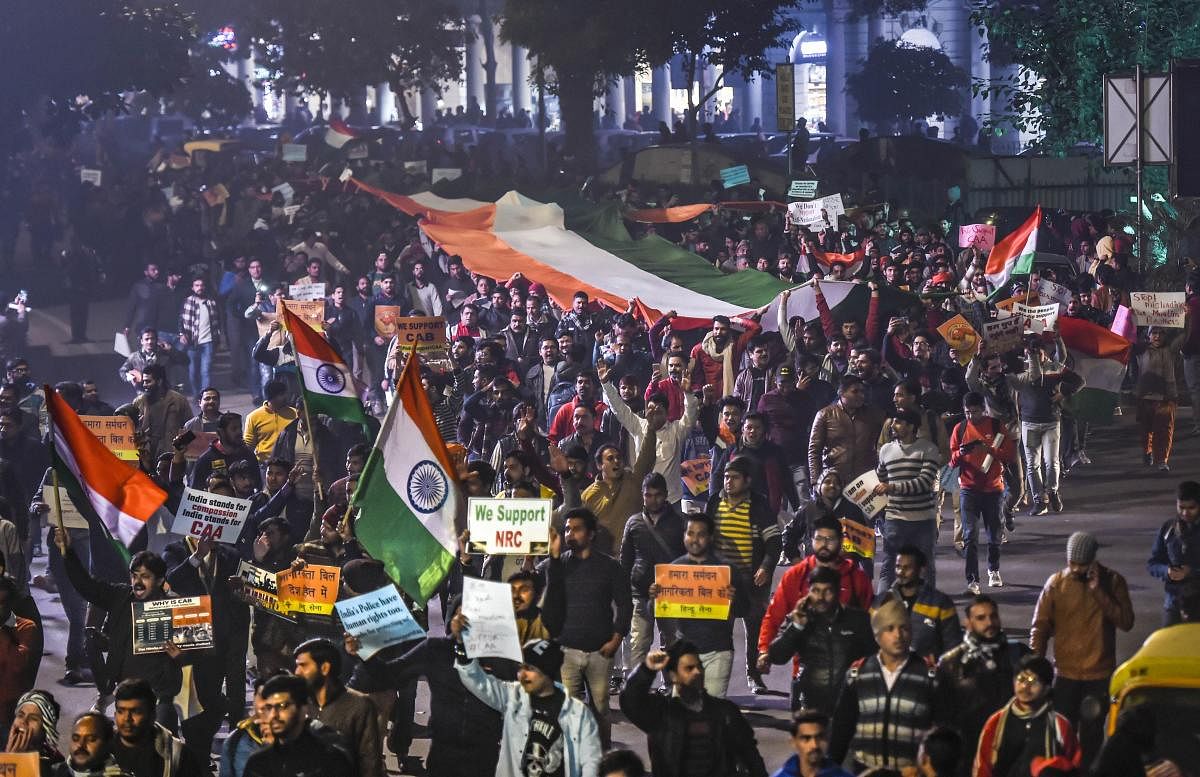The response of the State machinery and judiciary to the protests against the Citizenship Amendment Act casts a serious question on the rule of law in the country, which is guaranteed under Article 14 of the Constitution. The State’s action has been disproportionate and excessive, where there are frequent internet bans and violence is meted out to the protesters while the Supreme Court seems to be reluctant to protect people’s core fundamental rights.
Oppressive, excessive
The State has resorted to excessive measures in clamping down on the protests. In Jamia Milia Islamia, the university’s Chief Proctor reported that the police forcefully entered the campus when they had no permission to do so. Further, the State has sought to muzzle the voice of dissent by banning internet facilities in several parts of the country, including Assam, Aligarh, Mangaluru and other parts of the country and in parts of the national capital. The instant action short-circuited the legal/constitutional procedure for doing so. Section 144 prohibitory orders have been imposed in several parts of the country and peaceful protesters have been detained despite there being no potential threat from them. The imposition of Section 144 in Bengaluru, where peaceful protesters at Town Hall were detained without any cause, is one such example.
All these have serious adverse implications for substantive due process that draws its legitimacy from a legally aware public. The voice of the people needs to be heard and factored in better to strengthen democracy. Any instances of violence and legal violations needs to be dealt with in the manner and procedure established by law rather than by illegally storming into university campuses and libraries. When the government observes the rule of law, only then will the public have faith in the government and enforcement machinery.
Rule of law vs rule by law
Rule of law is part of the basic structure of the Constitution. In SP Gupta vs Union of India, the Supreme Court had observed that “the rule of law constitutes the core of our Constitution and it is the essence of the rule of law that the exercise of power by the State, whether it be the Legislature or the Executive or any other authority, should be within the constitutional limitations.” Further, rule of law is an inherent part of Article 14 of the Constitution.
British jurist AV Dicey conceptualised the rule of law based on three propositions:
a) Absence of discretionary power in the hands of governmental officials;
b) No person should be made to suffer in body or deprived of his property except for a breach of law established in the ordinary legal manner before the courts of the land;
c) The rights of the people must flow from customs and traditions of the people recognised by the courts in the administration of justice.
This implies that government should not use power arbitrarily or excessively. Doing so is antithetical to the rule of law.
Rule by/under law, on the other hand, confers unlimited power on the sovereign. It is based on the idea that the “King can do no wrong.” This system of law means that the sovereign can do anything and the sovereign itself is not subject to legal scrutiny. It confers unbridled power on the State machinery vis-à-vis the citizenry.
Approach of SC
The Supreme Court has been reluctant to interfere in the matter. When the matter was mentioned before it for urgent hearing, Chief Justice of India SA Bobde observed that violence must stop, else the Supreme Court would not hear the matter. It is pertinent to note that Article 32 of the Constitution, under which the petitioners approached the court, confers citizens a right to be heard for the enforcement of fundamental rights irrespective of any external factor. Babasaheb Ambedkar famously remarked that Article 32 was the “heart and soul of our Constitution.”
The Supreme Court attaching a prior condition is against the very Constitution that the court has been created to protect. Upon taking up the case, the Supreme Court refused to intervene and asked the petitioners to approach the High Court, saying that the latter was free to constitute a panel of retired High Court or Supreme Court judges to investigate the matter.
This approach of the top court is diametrically opposite to its activist approach. In the Hyderabad fake encounter case, the Supreme Court stayed the matter before the High Court and took cognizance of the case suo moto. It ordered a judicial enquiry into the matter by a former SC judge. It is incomprehensible why the Supreme Court did not extend the same protection to the present case, which poses a greater threat to the fundamental threads that hold the country together.
However, this is not the first time that the Supreme Court has done so. Recently, a few women approached the Supreme Court seeking protection for entry into Sabrimala temple. The CJI refused to entertain the matter because it was an “emotive issue” even though the court had remarked that the law was on the side of these women. In fact, it was the duty of the court to order the State to provide protection to these women, who had a rightful claim to it.
The way forward
It is pertinent to note Ambedkar’s exhortations during the Constituent Assembly Debates that democracy is only the top-dressing on Indian culture which is essentially undemocratic. We, Indians, must imbibe and cultivate constitutional morality. It is high time that we worked on these founding ideals of the Constitution. The executive must change its functioning and align itself with the Constitution. The judiciary, on the other hand, must act as guardian and protector of the Constitution, rather than enforcing rights on its whims and benevolence. It is the duty of every wing of the State to uphold the rule of law, and it must reflect in their daily functioning.
(The writer is a student at the National Law School of India University, Bengaluru)
